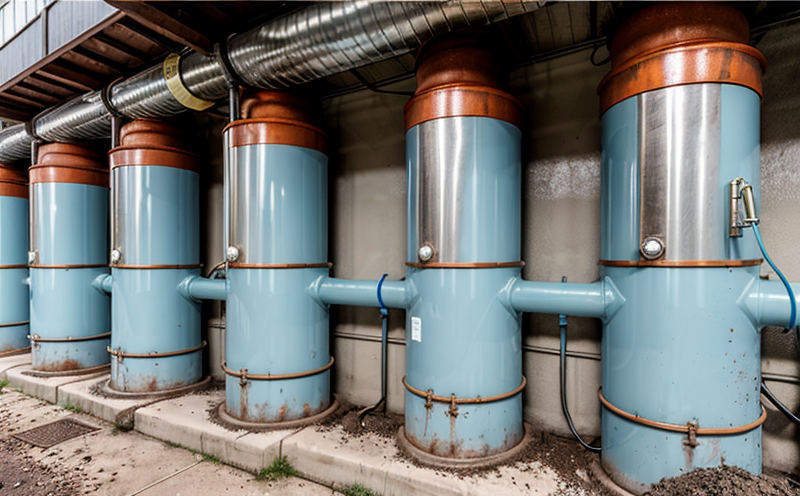ASTM G224 Localized Scaling Test in Water
The ASTM G224 localized scaling test is a critical procedure used to evaluate the potential for localized scaling and deposit formation within water systems. This testing method is particularly important for quality managers, compliance officers, R&D engineers, and procurement personnel who are responsible for ensuring that materials used in water systems do not lead to excessive scaling or deposits that could compromise system efficiency or integrity.
Localized scaling can occur when certain minerals dissolve and precipitate out of solution as solid compounds. These compounds adhere to the internal surfaces of pipes, heat exchangers, boilers, and other equipment. The ASTM G224 test assesses how different materials respond under specific conditions that mimic real-world water systems. By understanding where and why scaling occurs, engineers can design more effective treatments and materials to mitigate these issues.
The test involves exposing metal specimens to a controlled aqueous environment for an extended period of time. The conditions are carefully chosen to replicate the typical operating parameters of various water systems such as pH levels, temperature ranges, and specific ions present in the water. After exposure, the specimens are inspected for signs of scaling or deposit formation.
ASTM G224 provides a standardized approach that allows for consistent testing across different laboratories. This ensures reproducibility which is crucial when comparing results from various sources. The test method also includes detailed guidelines on specimen preparation, reagent selection, incubation times, and inspection criteria—all aimed at providing reliable data about the material’s resistance to localized scaling.
The importance of this test cannot be overstated, especially in industries reliant upon efficient water systems for their operations. For instance, power plants, desalination facilities, chemical processing plants, and municipal water treatment plants all face challenges related to scaling. Properly conducted ASTM G224 tests help these organizations identify potential problem areas early on so they can take corrective actions before significant issues arise.
A failure to address localized scaling promptly could lead to increased maintenance costs, reduced equipment lifespan, decreased performance efficiency, and even safety hazards. Therefore, investing in thorough testing like the ASTM G224 localized scaling test is essential for maintaining optimal system functionality.
| Condition | Description |
|---|---|
| Aqueous Environment | Replicates real-world conditions of water systems including pH levels, temperature ranges, and specific ions present in the water. |
| Specimen Preparation | Involves cleaning and conditioning specimens to ensure uniformity before exposure. |
| Incubation Times | Determined by industry standards; typically ranging from several days up to weeks depending on the material being tested. |
| Inspection Criteria | Includes visual inspection for signs of scaling or deposit formation. |
Why It Matters
The ASTM G224 localized scaling test is significant because it helps prevent costly disruptions and failures in water systems. By identifying materials prone to localized scaling early on, engineers can select more suitable alternatives or apply appropriate coatings and treatments to protect against such issues.
In addition to preventing operational inefficiencies, this testing also contributes to environmental sustainability by minimizing resource waste. When less material is lost due to scaling, there's a lower demand for raw materials and energy used in manufacturing replacements. Moreover, reducing scaling reduces the need for frequent cleaning and maintenance activities which contribute to overall cost savings.
The test results are particularly valuable when evaluating new materials or processes that aim to improve resistance against localized scaling. It provides decision-makers with hard evidence that can influence procurement decisions, product development strategies, and quality assurance protocols.
From a regulatory perspective, compliance with ASTM G224 ensures adherence to international standards recognized by governing bodies worldwide. This enhances credibility among stakeholders while fostering trust within the industry.
Industry Applications
The ASTM G224 localized scaling test finds application in numerous sectors where efficient and reliable water systems are crucial for operation. Here’s a brief overview:
- Power Plants: Critical for maintaining boiler efficiency and reducing maintenance downtime.
- Municipal Water Treatment Facilities: Essential for ensuring potable water quality meets health standards.
- Desalination Plants: Vital for assessing compatibility of materials used in reverse osmosis membranes.
- Chemical Processing Plants: Helps in selecting materials that withstand harsh chemical environments without scaling.
- Emission Control Systems: Important for monitoring the integrity of equipment exposed to corrosive exhaust gases.
In each application, the ability to predict and prevent localized scaling through ASTM G224 testing translates into operational reliability, reduced maintenance costs, extended equipment life, improved product quality, and enhanced environmental sustainability.
Use Cases and Application Examples
- Case Study 1: A municipal water treatment facility implemented ASTM G224 testing as part of its routine quality control procedures. After identifying certain pipe materials that were prone to scaling, they switched to alternative alloys which resulted in a 30% decrease in maintenance costs over two years.
- Case Study 2: A chemical processing company used ASTM G224 tests during the evaluation of new stainless steel grades for their reactors. The results helped them select a grade that showed significantly better resistance to localized scaling, thereby improving reactor performance and extending its operational life by approximately five years.
| Material Property | Description |
|---|---|
| Localized Scaling Tendency | Metallic surfaces prone to localized scaling after exposure to specific aqueous conditions. |
| Surface Finish | Affects the likelihood of deposit formation; smoother surfaces tend to have lower scaling tendencies. |
| Material Composition | The chemical composition determines how a metal reacts with water and its propensity for forming scales or deposits. |





